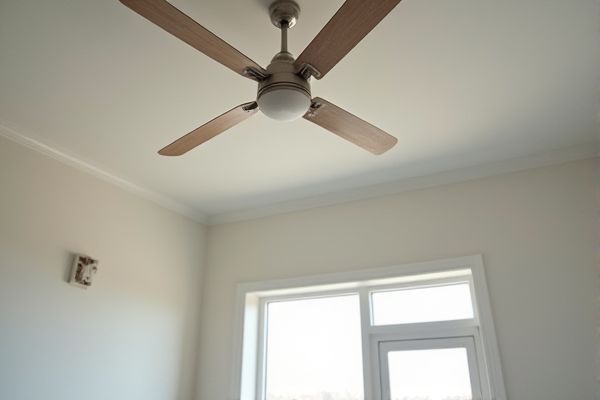
Overhead fans provide broad air circulation ideal for cooling larger spaces evenly, while wall-mounted fans offer targeted airflow with space-saving benefits, perfect for rooms with limited floor space. Discover which fan type best suits your cooling needs and how to optimize comfort in your environment by reading the full article.
Table of Comparison
| Feature | Overhead Fan | Wall-Mounted Fan |
|---|---|---|
| Installation | Ceiling-mounted, requires wiring and support | Mounted on wall, easier installation |
| Space Saving | Does not occupy floor or wall space | Frees floor space, uses wall area |
| Air Circulation | Provides broad, even airflow across room | Directs airflow to specific areas |
| Power Consumption | Typically higher wattage (70-120W) | Generally lower wattage (40-70W) |
| Noise Level | Generally quieter due to size and design | May produce more noise due to motor proximity |
| Cost | Moderate to high price range | Usually more affordable |
| Maintenance | Requires ladder access for cleaning and repairs | Easier access for maintenance |
| Best Use | Large rooms, whole-room ventilation | Small rooms, targeted airflow |
Introduction to Overhead Fans and Wall-Mounted Fans
Overhead fans provide widespread air circulation from the ceiling, making them ideal for cooling large rooms efficiently. Wall-mounted fans save floor space while delivering targeted airflow, perfect for small areas or rooms with limited ceiling height. Your choice depends on room size, cooling needs, and installation preferences to optimize comfort and ventilation.
Design and Installation Differences
Overhead fans typically feature a ceiling-mounted design requiring professional installation for proper wiring and secure mounting, making them ideal for centralized room airflow. Wall-mounted fans are designed for sidewall attachment, offering a space-saving solution with easier installation that often requires only basic tools and minimal electrical work. The structural requirements differ as overhead fans need strong ceiling support to handle the motor's weight and blade rotation, whereas wall-mounted fans depend on sturdy wall brackets to ensure stability and optimal airflow direction.
Airflow Distribution and Coverage
Overhead fans provide broad, circular airflow that evenly distributes air across larger areas, making them ideal for spacious rooms or open-plan layouts. Wall-mounted fans target airflow more directly toward specific zones, offering focused cooling with adjustable angles to cover localized spaces effectively. Choosing between the two depends on your need for either widespread circulation or targeted airflow coverage.
Energy Efficiency Comparison
Overhead fans generally consume less energy compared to wall-mounted fans due to their larger blade size and slower rotation speed, which allows for efficient air circulation over a wider area. Wall-mounted fans often require higher speeds to achieve similar cooling effects, leading to increased power consumption. Optimizing Your cooling system with an overhead fan can reduce electricity costs while maintaining effective airflow throughout the room.
Space and Aesthetic Considerations
Overhead fans save floor and wall space, making them ideal for rooms with limited room or cluttered walls, while providing a central, balanced airflow. Wall-mounted fans optimize floor space and are perfect for areas where ceiling installation is impractical, offering adjustable angles to direct airflow precisely. Aesthetically, overhead fans often blend seamlessly with ceiling design and provide a more traditional look, whereas wall-mounted fans can appear utilitarian but add a modern or industrial touch depending on the design.
Maintenance and Cleaning Requirements
Overhead fans typically require less frequent cleaning due to their elevated position, which minimizes dust accumulation, while wall-mounted fans need more regular maintenance to prevent dust buildup on blades and motor vents. You should inspect and clean wall-mounted fans monthly to ensure optimal airflow and avoid motor strain, whereas overhead fans often only need quarterly dusting and occasional lubrication. Proper maintenance extends the lifespan and efficiency of both fan types, with wall-mounted fans demanding more hands-on care.
Cost Analysis: Purchase and Installation
Overhead fans generally have a higher initial purchase price, averaging between $100 to $300 depending on size and features, with installation costs ranging from $150 to $300 due to electrical wiring and ceiling mounting requirements. Wall-mounted fans usually cost less upfront, between $50 and $150, with simpler installation expenses around $50 to $100 since they require only wall brackets and standard outlets. For your budget, consider the total cost of ownership, including both purchase and installation, as overhead fans offer more widespread airflow but come with higher installation complexity and expense.
Noise Levels and User Comfort
Overhead fans typically generate lower noise levels due to balanced blade rotation and distance from ear level, enhancing user comfort in large spaces by providing consistent airflow without disruptive sound. Wall-mounted fans may produce higher noise as vibrations transmit through the mounting surface, which can affect comfort especially in quieter environments. Selecting a fan based on noise tolerance and spatial requirements improves overall air circulation and user experience.
Ideal Applications and Room Types
Overhead fans are ideal for large rooms and open spaces such as living rooms, dining areas, and high-ceiling rooms where air circulation needs to cover a wide area efficiently. Wall-mounted fans suit smaller rooms or spaces with limited floor and ceiling space like kitchens, offices, and bedrooms, providing targeted cooling and adjustable airflow direction. Choosing between overhead and wall-mounted fans depends on room size, ceiling height, and the desired airflow coverage.
Pros and Cons Summary: Which Fan to Choose?
Overhead fans provide widespread air circulation and often come with adjustable speed settings, making them ideal for large rooms, but they require professional installation and fixed placement. Wall-mounted fans save floor space, are easier to install, and can be angled for targeted airflow, though they may not cool an entire room evenly. Your choice depends on room size, installation preferences, and whether you prioritize whole-room cooling or adjustable, direct airflow.
 homyna.com
homyna.com